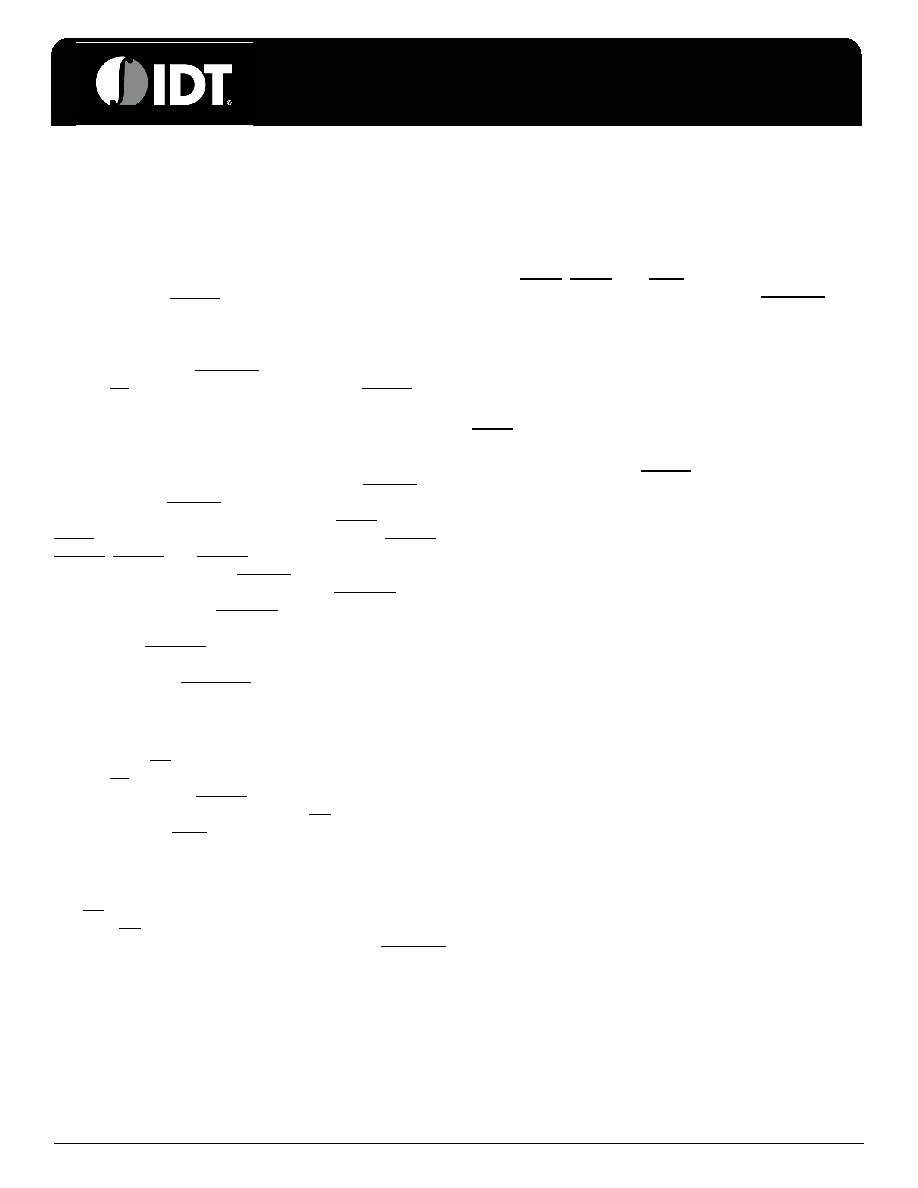- 您現(xiàn)在的位置:買賣IC網(wǎng) > PDF目錄98142 > SSTE32882HLBBKG (INTEGRATED DEVICE TECHNOLOGY INC) SSTE SERIES, PLL BASED CLOCK DRIVER, 4 TRUE OUTPUT(S), 0 INVERTED OUTPUT(S), PBGA176 PDF資料下載
參數(shù)資料
| 型號: | SSTE32882HLBBKG |
| 廠商: | INTEGRATED DEVICE TECHNOLOGY INC |
| 元件分類: | 時(shí)鐘及定時(shí) |
| 英文描述: | SSTE SERIES, PLL BASED CLOCK DRIVER, 4 TRUE OUTPUT(S), 0 INVERTED OUTPUT(S), PBGA176 |
| 封裝: | 8 X 13.50 MM, 0.65 MM PITCH, GREEN, MO-246F, CABGA-176 |
| 文件頁數(shù): | 1/69頁 |
| 文件大小: | 1263K |
| 代理商: | SSTE32882HLBBKG |
當(dāng)前第1頁第2頁第3頁第4頁第5頁第6頁第7頁第8頁第9頁第10頁第11頁第12頁第13頁第14頁第15頁第16頁第17頁第18頁第19頁第20頁第21頁第22頁第23頁第24頁第25頁第26頁第27頁第28頁第29頁第30頁第31頁第32頁第33頁第34頁第35頁第36頁第37頁第38頁第39頁第40頁第41頁第42頁第43頁第44頁第45頁第46頁第47頁第48頁第49頁第50頁第51頁第52頁第53頁第54頁第55頁第56頁第57頁第58頁第59頁第60頁第61頁第62頁第63頁第64頁第65頁第66頁第67頁第68頁第69頁

1.25V/1.35V/1.5V REGISTERING CLOCK DRIVER WITH PARITY TEST AND QUAD CHIP SELECT
1
SSTE32882KA1
7314/5
CONFIDENTIAL - THE INFORMATION IN THIS DOCUMENT IS SUBJECT TO CHANGE WITHOUT NOTICE
DATASHEET
Advanced Information
1.25V/1.35V/1.5V REGISTERING CLOCK DRIVER WITH PARITY
TEST AND QUAD CHIP SELECT
SSTE32882KA1
Description
This 28-bit 1:2, or 26-bit 1:2 and 4-bit 1:1, registering clock
driver with parity is designed for 1.25V, 1.35V and 1.5V VDD
operation.
All inputs are 1.25,1.35V and 1.5V CMOS compatible,
except the reset (RESET) and MIRROR inputs which are
LVCMOS. All outputs are 1.25V,1.35V and 1.5V CMOS
edge-controlled drivers optimized to drive single terminated
25
Ω to 50Ω traces in DDR3 RDIMM applications, except
the open-drain error (ERROUT) output. The clock outputs
(Yn and Yn) and control net outputs QnCKEn, QnCSn and
QnODTn are designed with a different strength and skew to
compensate for different loading and equalize signal travel
speed.
The SSTE32882KA1 has two basic modes of operation
associated with the Quad Chip Select Enable (QCSEN)
input. When the QCSEN input pin is open (or pulled high),
the component has two chip select inputs, DCS0 and
DCS1, and two copies of each chip select output, QACS0,
QACS1, QBCS0 and QBCS1. This is the "QuadCS
disabled" mode. When the QCSEN input pin is pulled low,
the component has four chip select inputs DCS[3:0], and
four chip select outputs, QCS[3:0]. This is the "QuadCS
enabled" mode. Through the remainder of this
specification, DCS[n:0] will indicate all of the chip select
inputs, where n=1 for QuadCS disabled, and n=3 for
QuadCS enabled. QxCS[n:0] will indicate all of the chip
select outputs.
The SSTE32882KA1 includes a high-performance,
low-jitter, low-skew buffer that distributes a differential clock
input (CK and CK) to four differential pairs of clock outputs
(Yn and Yn), and to one differential pair of feedback clock
outputs (FBOUT and FBOUT). The clock outputs are
controlled by the input clocks (CK and CK), the feedback
clocks (FBIN and FBIN), and the analog power inputs
(AVDD and AVSS). When AVDD is grounded, the PLL is
turned off and bypassed for test purposes.
The SSTE32882KA1 operates from a differential clock (CK
and CK). Data are registered at the crossing of CK going
high, and CK going low. The data is either driven to the
corresponding device outputs if exactly one of the DCS[n:0]
input signals is driven low.
Based on the control register settings, the device can
change its output characterisitics to match different DIMM
net topologies. The timing can be changed to compensate
for different flight time of signals within the target
application. By disabling unused outputs the power
consumption is reduced.
The SSTE32882KA1 accepts a parity bit from the memory
controller on the parity (PAR_IN) input, compares it with the
data received on the DIMM-independent data inputs (DAn,
DBAn, DRAS, DCAS, and DWE), and indicates whether a
parity error has occurred on the open-drain ERROUT pin
(active low). The convention is even parity; i.e., valid parity
is defined as an even number of ones across the
DIMM-independent data inputs combined with the parity
input bit. To calculate parity, all DIMM-independent D-inputs
must be tied to a known logic state.
The DIMM-dependent signals (DCKEn, DODTn, and
DCSn) are not included in the parity check computation.
To ensure defined outputs from the register before a stable
clock has been supplied, RESET must be held in the low
state during power-up.
The SSTE32882KA1 is available in a 176-ball BGA with
0.65mm ball pitch in a 11 x 20 grid. The device pinout
supports outputs on the outer two left and right columns to
support easy DIMM signal routing. Corresponding inputs
are placed in a-way that two devices can be placed
back-to-back for four Rank modules while the data inputs
share the same vias. Each input and output is located close
to an associated no ball position or on the outer two rows to
allow low cost via technology combined with the small
0.65mm ball pitch.
相關(guān)PDF資料 |
PDF描述 |
|---|---|
| SSTUA32864EC,557 | SSTU SERIES, POSITIVE EDGE TRIGGERED D FLIP-FLOP, TRUE OUTPUT, PBGA96 |
| SSTUA32866EC/G | 32866 SERIES, POSITIVE EDGE TRIGGERED D FLIP-FLOP, COMPLEMENTARY OUTPUT, PBGA96 |
| SSTUA32866EC,557 | 32866 SERIES, POSITIVE EDGE TRIGGERED D FLIP-FLOP, COMPLEMENTARY OUTPUT, PBGA96 |
| SSTUA32866EC/G,551 | 32866 SERIES, POSITIVE EDGE TRIGGERED D FLIP-FLOP, COMPLEMENTARY OUTPUT, PBGA96 |
| SSTUA32866EC/G,557 | 32866 SERIES, POSITIVE EDGE TRIGGERED D FLIP-FLOP, COMPLEMENTARY OUTPUT, PBGA96 |
相關(guān)代理商/技術(shù)參數(shù) |
參數(shù)描述 |
|---|---|
| SSTE32882HLBBKG8 | 制造商:Integrated Device Technology Inc 功能描述:Registering Clock Driver 176-Pin CABGA T/R 制造商:Integrated Device Technology Inc 功能描述:176 BGA (GREEN) - Tape and Reel 制造商:Integrated Device Technology Inc 功能描述:DDR3 LV REGISTER |
| SSTE32882KA1AKG | 功能描述:寄存器 RoHS:否 制造商:NXP Semiconductors 邏輯類型:CMOS 邏輯系列:HC 電路數(shù)量:1 最大時(shí)鐘頻率:36 MHz 傳播延遲時(shí)間: 高電平輸出電流:- 7.8 mA 低電平輸出電流:7.8 mA 電源電壓-最大:6 V 最大工作溫度:+ 125 C 封裝 / 箱體:SOT-38 封裝:Tube |
| SSTE32882KA1AKG8 | 功能描述:寄存器 RoHS:否 制造商:NXP Semiconductors 邏輯類型:CMOS 邏輯系列:HC 電路數(shù)量:1 最大時(shí)鐘頻率:36 MHz 傳播延遲時(shí)間: 高電平輸出電流:- 7.8 mA 低電平輸出電流:7.8 mA 電源電壓-最大:6 V 最大工作溫度:+ 125 C 封裝 / 箱體:SOT-38 封裝:Tube |
| SSTE32882KA1AKG8/M | 制造商:Integrated Device Technology Inc 功能描述:DDR3 REGISTER - Tape and Reel |
| SSTE32882TNA1AKG8 | 制造商:Integrated Device Technology Inc 功能描述:DDR3 REGISTER - Tape and Reel |
發(fā)布緊急采購,3分鐘左右您將得到回復(fù)。